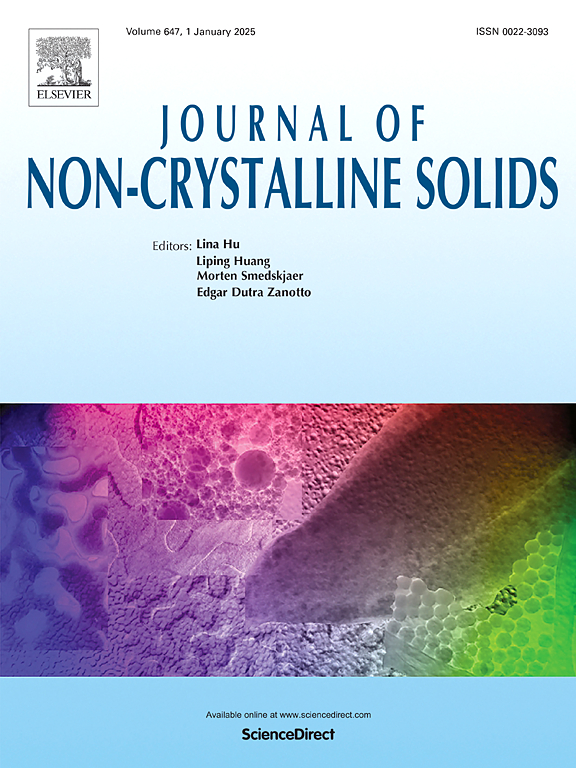Glass formation, structure and property of Nd3+-doped Sr(PO3)2-Ba(PO3)2-AlF3-MgF2 glass for 0.9μm fiber lasers
IF 3.5
3区 材料科学
Q1 MATERIALS SCIENCE, CERAMICS
引用次数: 0
Abstract
0.9 μm fiber lasers enable efficient generation of blue laser via second-harmonic conversion, which are essential light sources for applications such as undersea communications, laser displays, and biophotonic imaging. Glass fibers doped with Nd3+ ions serve as the gain medium for these lasers; however, the competition from the four-energy-level transition 4F3/2→4I11/2 remains a significant challenge. Fluorophosphate (FP) glass combines the high rare-earth solubility of phosphate glasses with the low phonon energy of fluoride, particularly benefiting from large crystal field strength that enhances the 4F3/2→4I9/2 transition. Nonetheless, crystallization and phase separation in FP glass pose substantial challenges for this multi-component glass system. Herein, a novel Nd3+-doped Sr(PO3)2−Ba(PO3)2−AlF3−MgF2 glass is reported. A thermodynamic approach was employed to predict the glass-forming region of the Sr(PO3)2−AlF3−MgF2 system, providing a robust design framework for FP compositions with superior glass-forming ability. Further investigations into the gradual substitution of Ba(PO3)2 to Sr(PO3)2 elucidate the structure-property relationship between the local network environment and Nd3+ emission at 0.9 µm. The optimized FP glass demonstrates remarkable stability against crystallization (ΔT>100 °C), a high branching ratio (47.2 %), a large emission cross-section (2.36 × 10−20 cm2), an extended lifetime (334 μs), a high spectral quality factor (7.88 × 10−24 cm2·s), and a broad gain bandwidth (10.71 × 10−26 cm3) at 0.9 μm, surpassing previously reported glass hosts and establishing it as a highly promising host material for 0.9 μm fiber laser applications.
掺Nd3+ Sr(PO3)2-Ba(PO3)2-AlF3-MgF2光纤激光器玻璃的形成、结构和性能
0.9 μm光纤激光器能够通过二次谐波转换高效地产生蓝色激光,这是海底通信、激光显示和生物光子成像等应用中必不可少的光源。掺有Nd3+离子的玻璃纤维作为激光器的增益介质;然而,来自四能级转换4F3/2→4I11/2的竞争仍然是一个重大挑战。氟磷酸盐(FP)玻璃结合了磷酸盐玻璃的高稀土溶解度和氟化物的低声子能量,特别是得益于大晶体场强,增强了4F3/2→4I9/2转变。尽管如此,FP玻璃的结晶和相分离对这种多组分玻璃系统构成了实质性的挑战。本文报道了一种新型掺Nd3+的Sr(PO3)2−Ba(PO3)2−AlF3−MgF2玻璃。采用热力学方法预测了Sr(PO3)2−AlF3−MgF2体系的玻璃形成区域,为具有优异玻璃形成能力的FP组合物提供了稳健的设计框架。对Ba(PO3)2逐渐取代Sr(PO3)2的进一步研究阐明了局域网络环境与0.9µm处Nd3+发射之间的结构-性质关系。优化后的FP玻璃具有优异的抗结晶稳定性(ΔT>100°C)、高分支比(47.2%)、大发射截面(2.36 × 10−20 cm2)、长寿命(334 μs)、高光谱质量因子(7.88 × 10−24 cm2·s)和0.9 μm宽增益带宽(10.71 × 10−26 cm3),超越了先前报道的玻璃主体材料,成为0.9 μm光纤激光器应用的极具前景的主体材料。
本文章由计算机程序翻译,如有差异,请以英文原文为准。
求助全文
约1分钟内获得全文
求助全文
来源期刊

Journal of Non-crystalline Solids
工程技术-材料科学:硅酸盐
CiteScore
6.50
自引率
11.40%
发文量
576
审稿时长
35 days
期刊介绍:
The Journal of Non-Crystalline Solids publishes review articles, research papers, and Letters to the Editor on amorphous and glassy materials, including inorganic, organic, polymeric, hybrid and metallic systems. Papers on partially glassy materials, such as glass-ceramics and glass-matrix composites, and papers involving the liquid state are also included in so far as the properties of the liquid are relevant for the formation of the solid.
In all cases the papers must demonstrate both novelty and importance to the field, by way of significant advances in understanding or application of non-crystalline solids; in the case of Letters, a compelling case must also be made for expedited handling.
 求助内容:
求助内容: 应助结果提醒方式:
应助结果提醒方式:


